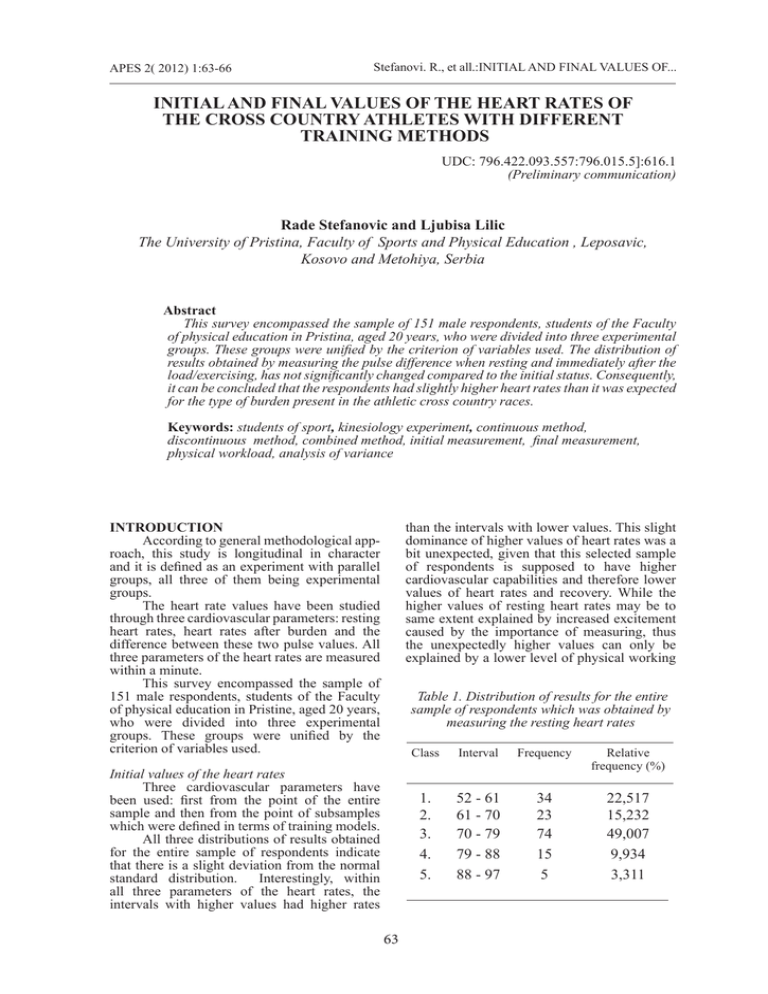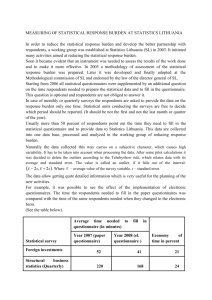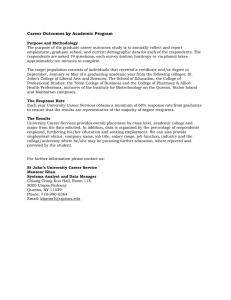initial and final values of the heart rates of the cross country athletes
advertisement

APES 2( 2012) 1:63-66
Stefanovi. R., et all.:INITIAL AND FINAL VALUES OF...
INITIAL AND FINAL VALUES OF THE HEART RATES OF
THE CROSS COUNTRY ATHLETES WITH DIFFERENT
TRAINING METHODS
UDC: 796.422.093.557:796.015.5]:616.1
(Preliminary communication)
Rade Stefanovic and Ljubisa Lilic
The University of Pristina, Faculty of Sports and Physical Education , Leposavic,
Kosovo and Metohiya, Serbia
Abstract
This survey encompassed the sample of 151 male respondents, students of the Faculty
of physical education in Pristina, aged 20 years, who were divided into three experimental
groups. These groups were unified by the criterion of variables used. The distribution of
results obtained by measuring the pulse difference when resting and immediately after the
load/exercising, has not significantly changed compared to the initial status. Consequently,
it can be concluded that the respondents had slightly higher heart rates than it was expected
for the type of burden present in the athletic cross country races.
Keywords: students of sport, kinesiology experiment, continuous method,
discontinuous method, combined method, initial measurement, final measurement,
physical workload, analysis of variance
INTRODUCTION
According to general methodological approach, this study is longitudinal in character
and it is defined as an experiment with parallel
groups, all three of them being experimental
groups.
The heart rate values have been studied
through three cardiovascular parameters: resting
heart rates, heart rates after burden and the
difference between these two pulse values. All
three parameters of the heart rates are measured
within a minute.
This survey encompassed the sample of
151 male respondents, students of the Faculty
of physical education in Pristine, aged 20 years,
who were divided into three experimental
groups. These groups were unified by the
criterion of variables used.
than the intervals with lower values. This slight
dominance of higher values of heart rates was a
bit unexpected, given that this selected sample
of respondents is supposed to have higher
cardiovascular capabilities and therefore lower
values of heart rates and recovery. While the
higher values of resting heart rates may be to
same extent explained by increased excitement
caused by the importance of measuring, thus
the unexpectedly higher values can only be
explained by a lower level of physical working
Table 1. Distribution of results for the entire
sample of respondents which was obtained by
measuring the resting heart rates
Initial values of the heart rates
Three cardiovascular parameters have
been used: first from the point of the entire
sample and then from the point of subsamples
which were defined in terms of training models.
All three distributions of results obtained
for the entire sample of respondents indicate
that there is a slight deviation from the normal
standard distribution.
Interestingly, within
all three parameters of the heart rates, the
intervals with higher values had higher rates
63
Class
Interval
Frequency
Relative
frequency (%)
1.
2.
3.
4.
5.
52 - 61
61 - 70
70 - 79
79 - 88
88 - 97
34
23
74
15
5
22,517
15,232
49,007
9,934
3,311
Stefanovi. R., et all.:INITIAL AND FINAL VALUES OF...
APES 2( 2012) 1:63-66
Table 2. Distribution of results obtained by
measuring the resting heart rates for the subsamples
of respondents who used continuous, discontinuous
and combined training
Class
Continuous
Discontinuous
Combined
1.
2.
3.
4.
5.
14
4
4
22
4
12
8
16
11
3
12
22
7
8
4
Class
1.
2.
3.
4.
5.
Table 3. Distribution of results for the entire sample
of respondents which was obtained bymeasuring
the heart rates after burden
Class
Interval
Frequency
1.
2.
3.
4.
5.
120,0 – 138,8
138,8 – 157,6
157,6 – 176,4
176,4 – 195,2
195,2 – 214,0
5
14
63
54
15
Relative
frequency (%)
3,311
9,272
41,722
35,762
9,934
Interval
Frequency
Relative
frequency (%)
1.
2.
3.
4.
5.
4
10
16
12
6
2
7
14
24
3
3
10
24
11
5
Interval
Frequency
Relative
frequency (%)
1.
2.
3.
4.
54,0 – 72,2
72,2 – 90,4
90,4 – 108,6
108,6 – 126,8
9
26
56
45
5,960
17,219
37,086
29,801
15
Combined
5
13
19
13
3
Parameter
Resting
heart
rates
Heart
rates after
exercising/load
Difference
M
Min
Max
S
V (%)
70,444
52
96t
9,439
13,399
175,03
120
213
16,843
9,622
104,609
54
144
18,748
17,92
M
63,208
64,880
68,113
S
8,720
7,142
8,642
F - test
4,706
P= 0,014
P= 0,014
Table 9. Final values of heart rates measured after
burden with key results of variance analysis
Class
126,8 – 145,0
Discontinuous
4
4
17
20
5
Table 7. Descriptive statistical data on heart rates
per minute for the entire sample of respondents
Training model
Continuous
Discontinuous
Combined
Table 5. Distribution of results for the entire sample
of respondents obtained by measuring the difference
between the resting heart rates and those
when exercising
5.
Continuous
4
16
6
12
10
Table 8. Final values of resting heart rates with key
results of variance analysis
Table 4. Distribution of results obtained by
measuring the heart rates after burden for
the subsamples of respondents who
used continuous,discontinuous and
combined training models
Class
Table 6. Distribution of results obtained
bymeasuring the difference between the resting
heart rates and those ones when exercising, for the
subsamples of respondents
Training model
M
S
F - test
Continuous
Discontinuous
Combined
166,708
163,300
165,208
17,722
17,354
15,658
0,501
P= 0,6067
P= 0,6067
Table 10. Final values of difference between resting
heart rates and those ones after burden with key
results of variance analysis
Training model
Continuous
Discontinuous t
Combined
9,934
64
M
103,5
98,42
97,094
S
18,200
17,734
18,449
F - test
1,721
P= 0,1824
P= 0,1824
APES 2( 2012) 1:63-66
Stefanovi. R., et all.:INITIAL AND FINAL VALUES OF...
CONCLUSION
The distribution of results obtained by
measuring the pulse difference when resting
and immediately after the burden/exercising,
has not significantly changed compared to the
initial status. Consequently, it can be concluded
that the respondents had slightly higher heart
rates than it was expected for the type of burden
present in the athletic cross country races.
The distribution of results for the
resting heart rates, within the entire sample of
respondents, showed considerable deviation
from the standard, which can be explained by
smaller excitement having already familiar
training task. The distribution of results obtained by measuring the heart rates after the
burden/exercising, has not significantly changed
compared to initial measuring. The distribution
of results obtained by measuring the difference
between resting heart rates and those ones
after the burden/exercising, hasn’t significantly
changed as well, compared to the initial status.
As for the descriptive statistical parameters of the heart rates, it can be said that
despite of some improvements, they were within standard values of healthy individuals except in certain cases; they didn’t deviate from the
average values even in the final measuring.
capability than expected. It is obvious that
the tested students of the Faculty of physical
education do not significantly differ in physical
and functional abilities than the average student
population.
As for the descriptive statistical parameters
of the heart rates, it can be said that they are
in the scope of standard values of healthy
individuals, except in certain cases, and they do
not significantly deviate from average values.
The low coefficients of variation indicate that
all obtained values are very homogeneous.
Relation between the heart rates of
the subsamples at the final measuring
The relation of the heart rate parameters
defined within the initial measurement also
remained unchanged after the final measurement.
Again, statistically significant difference was
established only within the resting heart rates
(Table 8), while the other two values (heart rates
after the burden and the pulse difference) were
not significantly different (Table 9 and 10).
As for the numerical values of the average
results, all three variables had lower values
compared to the initial measurement. This
was expected since most previous studies have
indicated the decrease of the heart rates for the
same burden as a result of systematic training.
The established relations indicated the
efficiency of all three used training models
(continuous, discontinuous and combined), but
due to the unchanging quantitative relations
between the average values of the subsamples
before and after the experimental treatment, it
wasn’t possible to conclude what training model
was the most effective and to what extent. The
solution for this dilemma was only possible
after comparing the results of final and initial
measuring.
REFERENCES
Đurđević, V. (1981). Sportsko srce [Sports hearts.
In Serbian.] Beograd: Sportska knjiga.
Gayton, A.C. (1996). Medicinska fiziologija
[Medical Physiology. In Serbian.] Beograd:
Savremena administracija, Medicinska
knjiga.
Stefanović, R. (1998): Uticaj različitih trenažnih
metoda na rezultat u krosu [Influence of
different methods on the training result in
cross. In Serbian.] (Unpublished doctoral
dissertation, University of Belgrade).
Beograd: Fakultet za fizičku kulturu.
INICIJALNI I FINALNI VREDNOSTI NA SRCEVATA
CENA NA RABOTA SO RAZLI^NI TRENA@NI
METODI KAJ KROS - TRKA^ITE
UDK: 796.422.093.557:796.015.5]:616.1
(Prethodno soop{tenie)
Rade Stefanovi} i Qubi{a Lili}
Univerzitet vo Pri{tina, Fakultet za sport i fizi~ko vospituvawe,
Leposavi}, kosovo i Metohija, Srbija
Apstrakt
Istra`uvaweto e realizirano na 151 ispitanik od ma{ki pol, studenti na
Fakultetot za fizi~ka kultura vo Pri{tina, na vozrast od 20 godini koi bea
65
APES 2( 2012) 1:63-66
Stefanovi. R., et all.:INITIAL AND FINAL VALUES OF...
podeleni vo tri eksperimentalni grupi so sli~na golemina. Grupite bea izedna~eni
spored kriteriumot na tretiranite varijabli. Podatocite od istra`uvaweto bea
obraboteni so analiza na varijansata. Distribucijata na dobienite rezultati od
presmetkite za razlikte na pulsot vo miruvawe i neposredno po optovaruvawen, ne
se promeni bitno vo odnos na inicijalniot status. Spored toa, konstatirano e deka
ispitanicite „pla}ale nezna~itelno pogolema cena na rabotata od onaa koja be{e
o~ekuvana za vidot na optovaruvaweto koe e karakteristi~no za atletskiot kros.
Klu~ni zborovi: studenti po sport, kineziolo{ki eksperiment,
kontinuirana metoda, diskontinuirana metoda, kombinirana metoda,
inicijalno merewe, finalno merewe, telesno optovaruvawe,
analiza na varijansa
Correpondence:
Rade Stefanović
University of Priština,
Faculty of Sport and Physical Education
Dositej Obradović bb, 38218, Leposavić,
Kosovo i Metohija, Srbija
E - mail: stefanovicrade5@gmail.com
66


